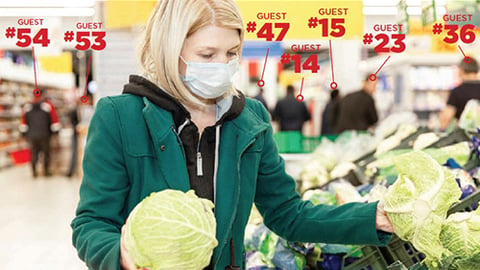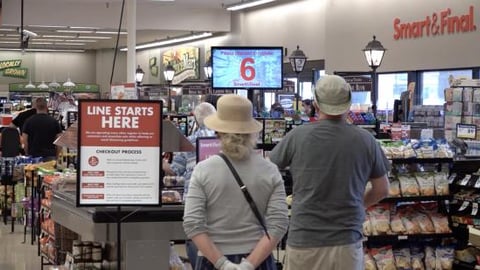Solving the Sanitation Challenge
Scientists all over the world are scrambling to expedite vaccine trials, launch antiviral drugs and create new diagnostic tests to help end the COVID-19 pandemic. But there’s another assailant threatening to disrupt global society, and especially food retail. The name of that enemy isn’t coronavirus. It’s fear.
If you are a food retailer, you might think that your No. 1 priority right now should be e-commerce or supply chain efficiency. While those certainly are important operational challenges to address, the most critical challenge in food retail today might just be finding a way to keep shoppers from being terrified of your store.
Key Takeaways
- Especially at a time of heightened concern about public health, a nightly deep clean is not enough.
- Grocers need to aggressively clean high-touch surfaces all day long.
- UV lights, foggers, EPA-approved virus killers and robots are retailers’ new friends.
According to a new report from C+R Research, a Chicago-based market insights firm, 60% of American consumers are now too scared — yes, scared — to shop at a grocery store due to the coronavirus. C+R Research recently surveyed more than 2,000 consumers to find out how the pandemic has changed their grocery shopping habits. More than 60% of consumers feel a sense of panic or anxiety about germs when they shop at a grocery store, and around 45% said that they disinfect their groceries when they bring them home.
Even more concerning, a big chunk of respondents (73%) said that they’re shopping less in physical stores than ever before, and more than one-third of shoppers said that they think food retailers should be doing more to protect consumers and employees from COVID-19. Of course, some of this fear can be explained by the grim headlines flooding shoppers’ TVs, computers and cellphones, many of which are painting food retailers in a negative light when it comes to store safety and cleanliness.
In Denver, for example, local news reported that a Walmart was forced to close after three COVID-19-infected employees died. In response, Walmart issued a statement saying that it would implement “a deep cleaning and disinfection of the entire store,” giving shoppers the impression that the store wasn’t actually clean before the deaths.
At least six Trader Joe’s stores have shut down temporarily for “precautionary cleaning and sanitization” after workers there were found to be infected. Meanwhile, workers at Safeway and Kroger stores around the country have died from COVID-19 as well, prompting more announcements about “enhanced sanitation” procedures.
The pandemic has shattered consumer confidence in the safety of grocery shopping, and for shoppers, the fear is all about sanitation and staying virus-free. While cleanliness has always been critical in food retail, the need to clean, sanitize and manage safety will never be as important as it is now, while this pandemic endures. Not only will retail sanitation measures need to be robust, but they’ll also need to be more effectively communicated for shoppers to maintain trust in the retailer.
“Just like our security measures changed forever after Sept. 11th, it is likely that cleaning expectations will not return to how things were,” asserts Bryan Smith, senior marketing manager for the Americas at Minneapolis-based Tennant Co., which manufactures retail cleaning equipment. “Customers are going to have higher standards when it comes to cleanliness. As a result, retailers are going to have to find new ways to meet this customer demand in an efficient and effective way.”
‘Disinfection Specialists’
These days, retailers may throw around words such as “sanitation” and “disinfection,” but there’s a big difference between them and another procedure called “sterilization”:
- Sanitation is another word for cleaning. Both words have the same meaning: removing visible contamination and debris, and dramatically lowering the number of germs on the surface.
- Disinfection is the destruction of viruses, bacteria and fungi on surfaces that have come in contact with skin. Proper disinfection leaves a surface highly unlikely to transmit infection or cause disease.
- Sterilization is the complete destruction of all microscopic life on a surface. Hospitals use sterilization on surgical tools, for example.
Food retailers already had effective programs for sanitation, designed primarily to keep food safe and to protect consumers, in place prior to the COVID-19 pandemic. Now the virus is putting pressure on companies to step up their protocols.
So what does “enhanced sanitation” mean? That definition will be different from retailer to retailer, but at the broadest level, “enhanced sanitation is a deep evaluation of what surfaces within your store will require more aggressive or frequent attention in your maintenance standards,” Smith says. “An appropriate focus should be on highly touched surfaces, but equally, retailers should be thinking about how they streamline the other cleaning processes to free up their teams’ time to give these focus areas more attention. It’s not just one thing, but a re-evaluating of the whole cleaning process to enable the new normal.”
Some grocers are meeting that new normal head-on by limiting store hours to thoroughly clean and disinfect their entire stores before opening the following morning (i.e., a deep clean). But that’s likely not going to be enough going forward. Grocers will need to more aggressively clean and sanitize high-touch surfaces throughout the day to reduce the risk of virus transmission.
“The new normal is constant cleaning throughout the day,” acknowledges Chris Wright, cleaning expert and VP at Brain Corp., a San Diego-based AI software company that powers robotic floor scrubbers from Tennant and other equipment manufacturers. “It used to be that the majority of cleaning happened on the third shift, and only spot cleaning happened during normal working hours. Now you are going to want to visibly show your customers that you are cleaning and actually draw attention to it. Having ‘disinfection specialists’ in brightly colored vests, and running cleaning or scanning robots during open hours, are all going to be the new normal. Doing these recognizable acts that are now in plain view to the public is important to the perception of a clean facility, and one that cares about their customers.”
The coronavirus is currently thought to be spread mainly from person to person through respiratory droplets, and is not known as of this writing to be transmitted through food or food packaging. However, it may be possible for a person to get sick by touching common surfaces that are contaminated with the virus and then touching the mouth, nose or eyes. Examples of these high-touch surfaces include checkout areas, shopping cart handles, touch screens, sneeze guards or door handles. Due to the virus’ ability to survive on surfaces for days, the Centers for Disease Control and Prevention (CDC) recommend that food retailers leverage EPA-registered cleaning and disinfecting products.
According to Jill Hollingsworth, VP of retail food safety and industry relations for St. Paul, Minn.-based Ecolab, a global leader in water, hygiene and energy technologies and services, enhanced sanitation measures in food retail should fall into three general categories: more frequent and detailed cleaning and sanitizing, disinfecting touch points and higher-risk areas throughout the facility, and focusing on people safety.
At Bentonville, Ark.-based Walmart, these enhanced sanitation measures are on full display, as all shopper traffic is directed to a single entrance and a greeter keeps count of how many shoppers are streaming into the store. Employees in every store are assigned to clean high-touch areas, such as checkouts and shopping carts, daily.
Minneapolis-based Target is taking additional sanitation steps in-store, including cleaning checkout lanes after each guest transaction, rotating the use of checkout lanes to allow those lanes not in use to be deep cleaned, and adding payroll hours to support more rigorous cleaning routines.
As part of H-E-B’s coronavirus action plan, the grocer has appointed dedicated teams of its associates and COVID-19 action managers in each store. These employees are trained to ensure “strict cleaning and sanitation protocols” are properly followed.
Boise, Idaho-based Albertsons Cos. says that it’s cleaning and disinfecting all departments, restrooms and other high-touch points of the store frequently throughout the day, as well as a deep cleanse at the end of each business day.
And Lakeland, Fla.-based Publix Super Markets has put in place “a heightened disinfection response program [and] also suspended food demonstrations in our stores until further notice.”
Pandemic Protocols
The actual cleaning practices and chemicals used may vary from retailer to retailer, based on their specific situations, but one universal best practice is to establish clear standard operating procedures to ensure that all stores are cleaned consistently, Smith advises.
“Tools like checklists, wall charts and training guides can all support this,” he says. “Any procedure should put highly touched surfaces like door and case handles, shopping carts, register areas, and conveyor belts under close scrutiny to ensure the proper level of disinfection for your store is achieved consistently.”
Smith adds that new cleaning innovations such as UVC lights and sanitizing foggers will become commonly implemented solutions.
In addition to the usual suspects such as carts and counters, Jimmy Timmins, director of sales at Auburn, Maine-based cleaning solution company KICTeam, says that retailers shouldn’t ignore transactional equipment.
He adds that best practices for this kind of equipment include cleaning and disinfecting the inside and outside of devices at the start and end of each shift, and cleaning both the inside and outside of the equipment (when turned off) with a pre-approved product, and then wiping down the outside of the equipment before wiping and drying with a microfiber cloth.
“It is important to clean the inside of media-handling equipment such as card readers, note acceptors, thermal printers, etc.,” Timmins says. “Credit cards have been seen to carry germs and bacteria, which can be deposited within the device. It is therefore critical to clean the inside of card readers as well as the outside.”
As far as how often retailers should clean and what types of products should be used, Smith says that there’s no single answer for any store, as the chemicals, process and frequency will depend on the surfaces being addressed and how people interact with them in each store. He defines cleaning as removing adherent soil and some invisible microbes, adding that disinfection is a regulated standard designed to use chemicals to destroy and kill certain microbes. Disinfecting chemicals must provide a 99.99% reduction in those specific microbes to meet the EPA-regulated standard.
“When designing protocols, it is important to remember you can clean without disinfecting, but you cannot disinfect without cleaning,” he notes. “A quality cleaning program will be important for all surfaces. For floors, normally a quality cleaning process is sufficient. Since walking on a disinfected floor immediately contaminates it, often disinfection is not advised.”
No matter the protocol, one thing is for certain: Food retailers will have to be more transparent about their cleaning practices, and that includes their ventilation systems. A study, published on the CDC’s website in April, suggested that an air conditioning unit at a restaurant in China may have contributed to as many as eight other people being infected with the coronavirus in January.
“There is no specific evidence of transmission via heating or cooling systems, but general guidance has been provided,” Hollingsworth says. “The suggestions are: (1) follow routine maintenance of HVAC systems, (2) increase air exchange when possible, (3) consider changing filters more frequently and switching to a higher-rated filter or a high-efficiency particulate (HEPA) filter.”








